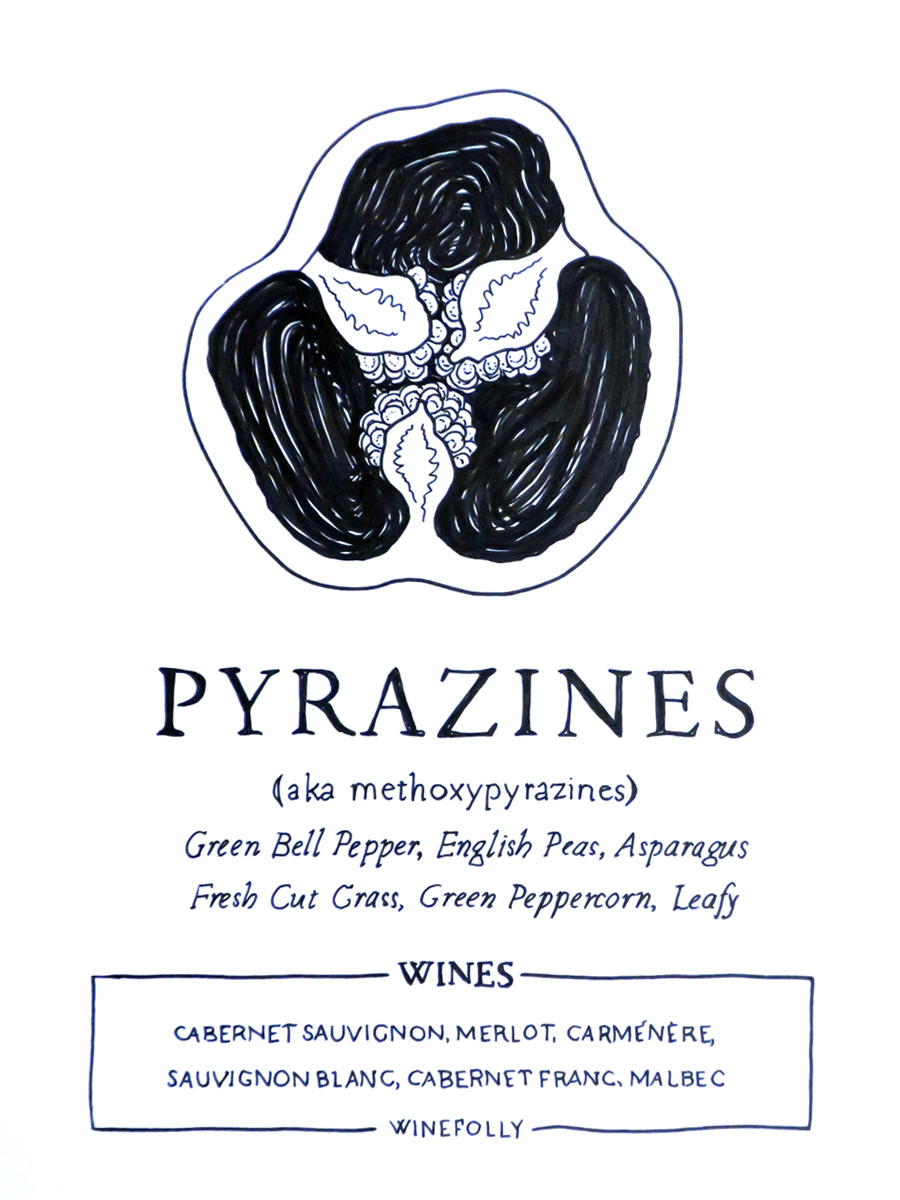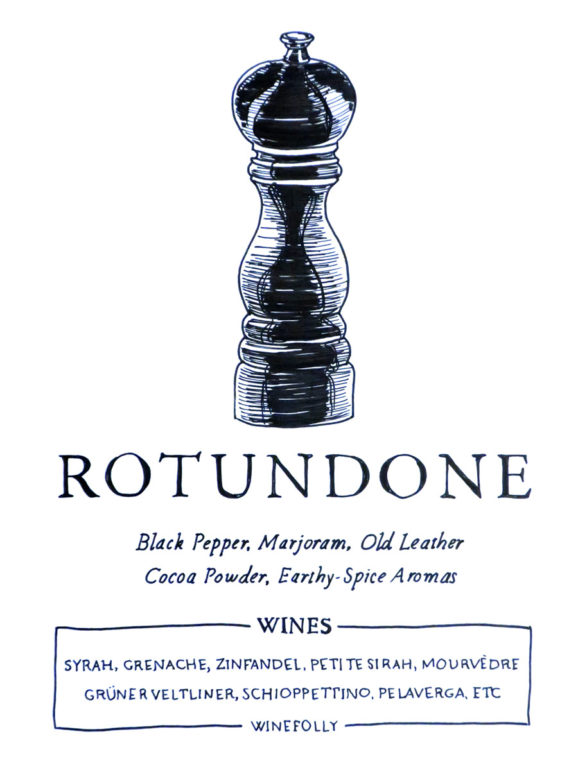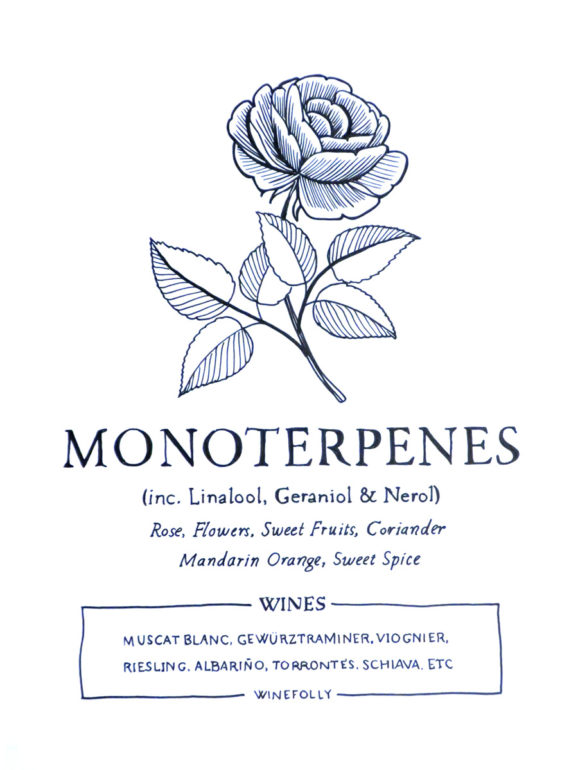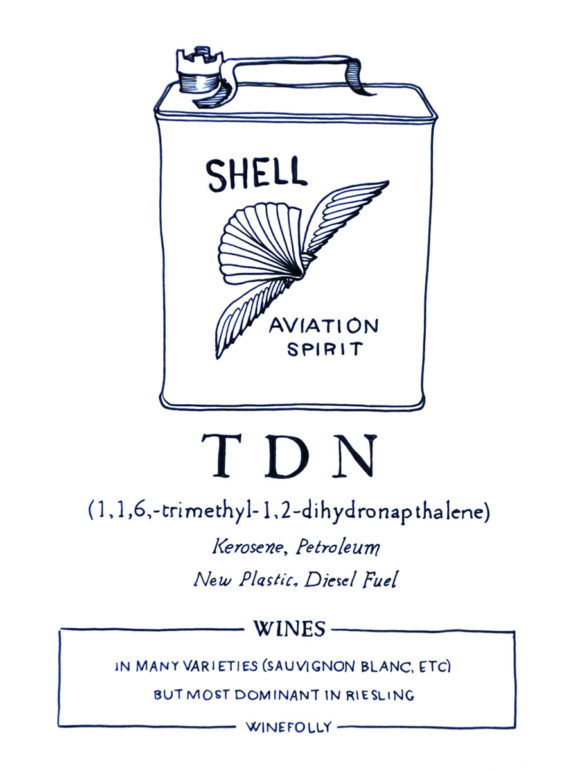It’s possible to smell over one hundred individual aroma compounds in wine that interact with each other. For blind tasters, impact compounds are like giant road markers pointing to specific wines.
Still, despite what you may have heard, it doesn’t matter if you’re a super taster or not, almost everyone can improve their sense of taste by learning to identify aroma compounds in wine.
For example, you may have stumbled across the smell of a fresh-cut green bell pepper or even the smell of gasoline. We call these signature smells “impact compounds,” (or “key food odorants” in the science community) because of their presence in wines.
6 Impact Compounds to Know
Pyrazines (methoxypyrazine)
Smells Like: Bell Pepper, Fresh Cut Grass, Green Peppercorn, Asparagus, Pea, Earth
Wines: Cabernet Sauvignon, Merlot, Malbec, Carménère, Sauvignon Blanc, Cabernet Franc, etc.
Pyrazines are most commonly associated with Bordeaux-origin varieties. In red wines, it’s often a touch more difficult to sense. Pyrazines can sometimes taste like raw cocoa or dark-chocolate.
Most wine drinkers find this compound class to be a positive trait in white wines but a negative one in red wine. In fact we’ve noticed that Robert Parker of the Wine Advocate consistently rates Bordeaux (and Napa) Cabernet wines lower if they have noticeable methoxypyrazine.
Interestingly enough, as red wines age, pyrazine seems to lose its edge, revealing cherry and chocolate-like notes. So, maybe it’s not so bad if you’re cellaring wine for the longer term.
There are 3 primary methoxypyrazines which contribute “vegetal” aromas: 2-methoxy-3-isobutylpyrazine (IBMP) giving earthy, grassy, and green bell pepper aromas; 2-methoxy-3-isopropylpyrazine (IPMP) giving aromas of asparagus, peas, and earth; and, 2-methoxy-3-alkylpyrazine with gives roasty and nutty aromas. Matt Kirkland, M.D. winescholardguild.com
Rotundone
Smells Like: Black Pepper, Marjoram, Leathery, Cocoa Powder, Earthy Spice Flavors
Wines: Syrah, Grenache, Zinfandel, Petite Sirah, Grüner Veltliner, Schioppettino, Mourvèdre, Pelaverga, etc.
This compound is the key ingredient in black and white peppercorns and is about 10,000 times less prevalent in wine. Still, human sensitivity to this compound is quite high so it plays an important role in the flavor profiles of the wines that contain it. This is the impact aroma that gives red and white wines a spicy taste.
Monoterpenes
Smells Like: Rose, Flowers, Sweet Fruits, Mandarin Orange, Coriander, Sweet Spice
Wines: Gewürztraminer, Viognier, Riesling, Albariño, Muscat Blanc, Schiava, Torrontés, Cotton Candy Grapes etc.
The more pronounced monoterpenes include the compounds of linalool, geraniol, and nerol. They produce floral aromas in wine. These are the same aroma compounds used to create sweet-smelling perfumes, soap, and shampoo, so it’s no surprise that some people might describe these wines as having a “soapy” smell. What’s interesting about these aromas is unlike the other compounds, you can taste these in raw grapes.
Sotolon
Smells Like: Cumin, Maple Syrup, Walnuts, Molasses, Roast Tobacco
Wines: Found in oxidized wines such as Madeira, Vin Jaune, Sherry, Old Sauternes, Old Chardonnay, very old Red Wines
This is the major flavor compound found in fenugreek seeds and lovage (a unique green herb). In wine, it comes from oxidation and is most prevalent in fortified wines like Sherry and Madeira. You can also taste it if you age a white wine for about 7-10 years–this aroma is an intriguing thing to look forward to identifying when trying old wines.
TDN (aka 1,1,6,-trimethyl-1,2-dihydronapthalene )
Smells Like: Kerosene, Petroleum, Diesel Fuel
Wines: In many varieties (Sauvignon Blanc, Chardonnay, etc) but is most noticeable in Riesling
This aroma is one of the few aroma compounds that is almost non-existent in grapes and increases in wine as it ages. The wines noted with the strongest petrol-like aromas come from warmer vintages because the compound develops as grapes are exposed to sunlight.
Diacetyl
Smells Like: Butter, Cream
Wines: Wines that have undergone Malolactic Fermentation (Red Wines, Chardonnay, Viognier, etc.)
This compound is much more pronounced in white wines but adds an aspect to red wine that’s often described as creamy or velvety. Diacetyl comes from the post-fermentation process called Malolactic Fermentation which involves bacteria eating malic acid and pooping out lactic acid (sounds delicious right?). The result gives wine this awesome creamy and buttery aroma and texture. By the way, very few white wines undergo this process which is one of the primary reasons they taste so much different than red wines.





